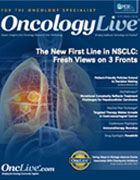Publication
Article
Oncology Live®
Targeted Therapy Makes Inroads in Gastroesophageal Cancer
Author(s):
Gastroesophageal cancer (GEC) is a complex disease, encompassing cancers with different histological and molecular subtypes. Growing insight into the molecular biology of GEC is poised to change the treatment landscape for this disease, although many questions remain unanswered.
Johanna C. Bendell, MD

Johanna C. Bendell, MD
Gastroesophageal cancer (GEC) is a complex disease, encompassing cancers with different histological and molecular subtypes. Growing insight into the molecular biology of GEC is poised to change the treatment landscape for this disease, although many questions remain unanswered.
OncLive recently assembled a distinguished panel of experts to discuss the evolving treatment paradigm for advanced GEC. In addition to discussing the complex epidemiology of GEC, the Peer Exchange panel reviewed findings from studies of emerging therapeutic regimens.
Four Subtypes Identified
Classes of targeted agents that have shown promise for GEC include monoclonal antibodies, antiangiogenic agents, and immunotherapy drugs. Some targeted therapies, such as trastuzumab (Herceptin) and ramucirumab (Cyramza), have already been approved for certain types of GEC.To add context to recent developments in managing GEC, it helps to understand the different cancer subtypes and their geographic distribution. Although GEC is rare in the United States, it is relatively common in Asian countries.1
Ian Chau, MD, FRCP, noted that gastric cancer is the third most common cause of cancer death in Asia and the second most common cause if esophageal cancer is included.
Esophageal cancer is divided into 2 histological subtypes: squamous cell carcinoma (ESCC) and adenocarcinoma (EAC). Whereas ESCC is the predominant subtype in Asia and developing countries, EAC accounts for most US cases of esophageal cancer.2
During the past several years, the incidence of EAC, which primarily affects the lower esophagus (the gastric junction), has been increasing in Western countries, including in the United States.2 “A lot of it is because of gastroesophageal reflux disease, and that might be related to obesity, which is becoming more and more common in the Western world,” Chau said.
In 2014, the Cancer Genome Atlas (TCGA) completed a molecular evaluation of 295 gastric adenocarcinomas and proposed 4 major subtypes of gastric cancer3:
- Epstein-Barr virus—associated tumors, most of which contain PIK3CA mutations, have excessive DNA hypermethylation, and overexpress JAK2, PD-L1, and PD-L2
- Microsatellite unstable tumors, which can also have PIK3CA mutations and commonly overexpress HER2 or EGFR
- Genomically stable gastric cancers, characterized by CDH1 and RHOA mutations and the CLDN18-ARHGAP fusion
- Tumors with chromosomal instability, including TP53 mutations and RTK-RAS, VEGFR, and p110 amplifications
Immune Checkpoint Inhibitors
The TCGA analysis and subsequent studies carried out by other research groups have identified several potential therapeutic targets in GEC. Approved therapies already exist for some of these targets, but must still be validated in patients with GEC. Researchers are also investigating whether novel targeted agents alone or in combination can prolong survival and reduce the unwanted toxicities of systemic chemotherapy.Immune checkpoint inhibitors prevent cancer cells from initiating a signaling cascade that ultimately blunts the response of activated T cells to the cancer. “The whole concept of immunotherapy is where you get your own immune system to attack the tumor,” said Johanna C. Bendell, MD, who served as moderator for the Peer Exchange discussion.
The first checkpoint inhibitors were approved to treat advanced melanoma, and subsequently for lung cancer, renal cell carcinoma, Hodgkin lymphoma, head and neck cancer, and bladder cancer.4 Checkpoint inhibitors are currently being studied in a host of other cancer types, including GEC. Most target PD-1, a protein that binds to PD-L1 and PD-L2.
“If you look at the mutational burden of the tumors that have been historically studied and targeted with checkpoint inhibitors, such as melanoma and subtypes of lung cancer, gastric cancer is actually very close to the mutational burden on that spectrum,” said Yelena Y. Janjigian, MD. She said this is because the gastrointestinal mucosa is often subjected to repeated DNA damage (and repair) due to chronic inflammation or Helicobacter pylori infection.
Nivolumab is a PD-1 inhibitor approved in the United States for melanoma and several other cancers. The CheckMate-032 study evaluated the safety and efficacy of nivolumab in 59 heavily treated patients with advanced or metastatic gastric or gastroesophageal junction cancer.5 These patients have few options and a poor prognosis.
According to data presented at the 2016 American Society of Clinical Oncology (ASCO) Annual Meeting, the overall response rate (ORR) was 12% and median overall survival (OS) was 7 months. In the subset of patients with PD-L1—positive tumors, the ORR was 18%.5
More recently, Bristol-Myers Squibb, which manufactures nivolumab, publicized preliminary data from the ONO-4538-12 study, which was a phase III trial evaluating nivolumab in Asian patients with unresectable, advanced, or recurrent gastric or gastroesophageal junction cancer. The ORR was 14%, which increased to 27% in a subset analysis of patients with PD- L1—positive disease,6 the company said.
“I think what impresses everybody the most [about checkpoint inhibitors] is these durable responses that can even go on for years,” Bendell said. Despite this, Chau noted that it can take weeks for checkpoint inhibitors to take effect and advised caution when selecting patients for immunotherapy. Janjigian agreed that checkpoint inhibitors are probably not the best option for patients who are presenting with obstructive symptoms or peritoneal carcinomatosis.
Antiangiogenic Agents
Combining checkpoint inhibitors may increase the risk of toxicities. Janjigian said in her experience, combining a PD-1 inhibitor with a checkpoint inhibitor that targeted CTLA-4 was associated with a higher response rate, but also an increase in grade 3/4 toxicities. “Instead of febrile neutropenia and neuropathy, these patients get potentially life-threatening immune processes,” she said.After disappointing results from the AVAGAST first-line trial of the VEGF inhibitor bevacizumab, it was unclear whether antiangiogenic agents had a role in GEC.7 The panel discussed how AVAGAST’s multinational population may have contributed to the trial’s failure to meet its primary endpoint. “Asians really don’t seem to derive any benefit from bevacizumab, either in progression-free survival [PFS] or OS, whereas the Pan-Americans seem to have some benefits,” Chau said.
In contrast to AVAGAST, both the phase III RAINBOW and REGARD trials observed significant benefits with the VEGF/HER2 inhibitor ramucirumab in patients with GEC.8 The study findings prompted the FDA to approve ramucirumab for GEC.
Manish Shah, MD, highlighted differences between the protocols for AVAGAST and the ramucirumab trials. “RAINBOW and REGARD were second-line studies...Also, the proportion of patients from Asia were limited in those studies.” Subgroup analyses of RAINBOW data associated ramucirumab with superior PFS relative to placebo in Japanese and Western cohorts. But only the Western population experienced improvement in OS. Shah said modeling suggests that using a higher dose of ramucirumab might improve survival outcomes.
Chau praised REGARD as “the first randomized controlled trial that shows an antibody against VEGF has a survival advantage.” He also praised the drug’s safety profile, which was highly favorable in both studies. Although ramucirumab is typically given with paclitaxel, Chau said that because data established ramucirumab as effective monotherapy, he feels comfortable discontinuing paclitaxel if a patient develops neuropathy. Bendell said that based on the favorable findings, she would like to see a trial of ramucirumab plus chemotherapy in the first-line setting.
Combining Targeted Therapies
Apatinib is a novel VEGF-HER2 inhibitor and was evaluated in a phase III trial of Chinese patients with chemotherapy-refractory GEC.9 The apatinib arm had significantly longer median OS than the placebo group and longer PFS. Shah said the findings of the Chinese study, combined with the results of RAINBOW and REGARD, support a role for VEGF inhibition in GEC.Janjigian predicted that combination regimens are the future paradigm for GEC due to its molecular complexity. “Because of the nature of the epithelium and where the tumor is located, it will be important to find combinations of targeted agents that will help us control the tumor if we ever want to move away from cytotoxic chemotherapy,” she said.
Several experts on the panel are currently conducting clinical trials that combine targeted agents. Janjigian is involved in a trial that is evaluating the HER2 inhibitor trastuzumab with a PD-1 inhibitor in patients with GEC.
Bendell, Chau, and their colleagues are conducting a phase I trial that pairs the PD-1 inhibitor pembrolizumab with ramucirumab in patients with solid tumors, including GEC.10 Chau explained the rationale behind the combination: “Preclinical evidence says that if you give a tumor low-dose antiangiogenic therapy, you change it from an immunosuppressive environment to a much more immunosupportive environment.”
Despite Progress, Challenges Remain
Safety data they presented at the 2016 ASCO Annual Meeting shows “the 2 drugs [together] are very safe—hardly any grade 3/4 toxicity or even grade 2 toxicities,” said Chau. The study is being expanded to include patients naïve to cytotoxic chemotherapy, and they hope to present efficacy data next year.As the session ended, Shah expressed appreciation for how much progress researchers have made. “In the last 10 years, we have 5 new drugs that have been approved [for GEC],” he said. The panelists acknowledged that despite the tremendous progress, GEC remains a difficult disease to treat and much more needs to be done.
Shah said improving outcomes and patients’ quality of life will depend on “learning to sequence the drugs and combine them in a smarter way to understand the molecular profiles and to be proactive in terms of managing the patient’s side effects.”
References
- Kamran SC, Hong TS, Wo JY. Advances in the management of gastric and gastroesophageal cancers. Curr Oncol Rep. 2016;18(2):13. doi: 10.1007/s11912-015-0493-6.
- Zhang HZ, Jin GF, Shen HB. Epidemiologic differences in esophageal cancer between Asian and Western populations. Chin J Cancer. 2012;31(6):281-286. doi: 10.5732/cjc.011.10390.
- Chen T, Xu XY, Zhou PH. Emerging molecular classifications and therapeutic implications for gastric cancer. Chin J Cancer. 2016;35:49. doi: 10.1186/s40880-016-0111-5.
- Cancer Research Institute. Timeline of progress. http://www.cancerresearch.org/our-strategy-impact/timeline-of-progress/ timeline-detail. Accessed November 28, 2016.
- Le DT, Bendell JC, Calvo E, et al. Safety and activity of nivolumab monotherapy in advanced and metastatic (A/M) gastric or gastroesophageal junction cancer (GC/GEC): results from the CheckMate-032 study. J Clin Oncol. 2016;34(suppl 4S; abstr 6).
- Opdivo (nivolumab) Demonstrates overall survival benefit in patients with unresectable advanced or recurrent gastric cancer in phase III study [press release]. Princeton, NJ: Bristol-Myers Squibb; November 10, 2016. http://news.bms.com/press-release/bmy/opdivo-nivolumab-demonstrates-overall-survival-benefit-patients-unresectable-advan. Accessed November 28, 2016.
- Ohtsu A, Shah MA, Van Cutsem E, et al. Bevacizumab in combination with chemotherapy as first-line therapy in advanced gastric cancer: a randomized, double-blind, placebo-controlled phase III study. J Clin Oncol. 2011;29(30):3968-3976. doi: 10.1200/JCO.2011.36.2236.
- Javle M, Smyth EC, Chau I. Ramucirumab: successfully targeting angiogenesis in gastric cancer. Clin Cancer Res. 2014;20(23):5875- 5881. doi: 10.1158/1078-0432.CCR-14-1071.
- Li J, Qin S, Xu J, et al. Randomized, double-blind, placebo-controlled phase III trial of apatinib in patients with chemotherapy-refractory advanced or metastatic adenocarcinoma of the stomach or gastroesophageal junction. J Clin Oncol. 2016;34(13):1448-1454. doi: 10.1200/JCO.2015.63.5995.
- Herbst RS, Bendell JC, Isambert N, Calvo E, Santana-Davilla R, Cassier P, Perez-Garcia J, Yang J, Rege J, Ferry D, Mi G, Chau I. A phase I study of ramucirumab (R) plus pembrolizumab (P) in patients (pts) with advanced gastric or gastroesophageal junction (G/GEJ) adenocarcinoma, non-small cell lung cancer (NSCLC), or urothelial carcinoma (UC): phase Ia results [ASCO abstract 3056]. J Clin Oncol. 2016;34(suppl; abstr 3056).










